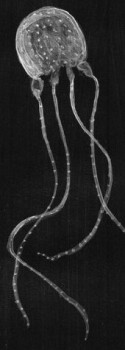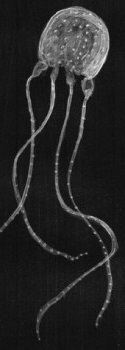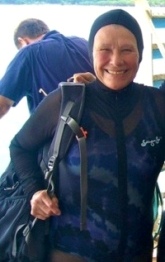Interesting Facts
Discovery in an Unusual Way
Wikimedia Commons: GondwanaGirl
 Dr. Jack Barnes was a medical doctor in Australia
that saw many patients come to the hospital, suffering from a jellyfish sting,
and a number of them claimed to have never seen the culprit of their sickness.
This hellish sickness had already been given the name “Irukandji
Syndrome,” but the species responsible was not yet known. Dr. Barnes was
determined to discover the organism and deduced that he had to go in the water
because no one had ever found such a species on shore. So, he swam in unsafe
water where jellyfish stings were frequent. On December 10, 1961
he barely noticed a tiny, rather translucent jelly float in front of the glass
of his diver’s mask. He captured it, and a life guard, Don Ludbey, captured
another when he had noticed “an erratically swimming fish” that was being stung
by the organism. In order to conclude whether this was the culprit of
Irukandji Syndrome, Dr.
Barnes decided to perform a crazy experiment: He stung himself, his nine
year-old son, and life guard Don Ludbey. Within thirty minutes, they
were all experiencing extreme symptoms, proving that this little jellyfish was
indeed that cause of
Irukandji Syndrome. All three thankfully survived. This organism is now
named after its discoverer: Dr. Jack Barnes and Carukia barnesi.
(Nickson 2009)
Dr. Jack Barnes was a medical doctor in Australia
that saw many patients come to the hospital, suffering from a jellyfish sting,
and a number of them claimed to have never seen the culprit of their sickness.
This hellish sickness had already been given the name “Irukandji
Syndrome,” but the species responsible was not yet known. Dr. Barnes was
determined to discover the organism and deduced that he had to go in the water
because no one had ever found such a species on shore. So, he swam in unsafe
water where jellyfish stings were frequent. On December 10, 1961
he barely noticed a tiny, rather translucent jelly float in front of the glass
of his diver’s mask. He captured it, and a life guard, Don Ludbey, captured
another when he had noticed “an erratically swimming fish” that was being stung
by the organism. In order to conclude whether this was the culprit of
Irukandji Syndrome, Dr.
Barnes decided to perform a crazy experiment: He stung himself, his nine
year-old son, and life guard Don Ludbey. Within thirty minutes, they
were all experiencing extreme symptoms, proving that this little jellyfish was
indeed that cause of
Irukandji Syndrome. All three thankfully survived. This organism is now
named after its discoverer: Dr. Jack Barnes and Carukia barnesi.
(Nickson 2009)
Protection from Stings
Flickr: Matt Hobbs |
 In 2009 Lisa-ann Gershwin and Karen
Dabinett published a research paper named “Comparison of Eight Types of
Protective Clothing against Irukandji Jellyfish Stings.” This study was
initiated by Surf Life Saving (SLS).
Gershwin and Dabinett explained
that these types of experiments need to be done because “less than five
percent of Queensland beach users wear any type of stinger protection,”
one-third of Irukandji stings occur in coral reef environments where tourist and researches
swim and dive often, and jellyfish stings are considered the “number one health
hazard in tropical Australian waters.” For the data collection, they
used two body suits meant for jellyfish sting protection, three types of panty
hose, and three types of sportswear suits.
Gershwin and Dabinett applied and
dragged tentacles across the materials and then observed many different factors:
In 2009 Lisa-ann Gershwin and Karen
Dabinett published a research paper named “Comparison of Eight Types of
Protective Clothing against Irukandji Jellyfish Stings.” This study was
initiated by Surf Life Saving (SLS).
Gershwin and Dabinett explained
that these types of experiments need to be done because “less than five
percent of Queensland beach users wear any type of stinger protection,”
one-third of Irukandji stings occur in coral reef environments where tourist and researches
swim and dive often, and jellyfish stings are considered the “number one health
hazard in tropical Australian waters.” For the data collection, they
used two body suits meant for jellyfish sting protection, three types of panty
hose, and three types of sportswear suits.
Gershwin and Dabinett applied and
dragged tentacles across the materials and then observed many different factors:
1. Penetrability- C. barnesi tentacles are only
one-fourth
millimeter in diameter, making it easy to get
through many looser knitted materials
2. Adherence- tentacles remaining stuck to
material can still
sting while taking off a suit
3. Crushing- if tentacles could be crushed through the fabric
4. Durability- how often will divers and swimmers need to
replace their protective suits
5. Heat retention- a major problem for
many divers and
swimmers who stay in the warm water,
under a hot sun, for long periods of time
6. Exposed skin- remember Irukandjis are tiny
and
can potentially sting ANY part of your body
7. Cost- always an issue of course, especially
if you’re
vacationing on a tight budget!
flickr: Holly VanDine
Gershwin and Dabinett concluded that there is no perfect protective suit. Often times, if one suit had small holes and thicker material, heat retention became an issue, or larger holes and thinner material left larger amounts of skin exposed, but were cheaper and decreased the possibility of heat retention. Gershwin, Dabinett, and SLS do not promote one particular type or brand of protective suit, but they do stress one key point that everyone should keep in mind when heading to beaches that have jellyfish (f.y.i., not just Australia has jellyfish!).
It is strongly recommended that when swimming in waters known to have jellyfish, some amount of the body, if not the entire body, should be covered with some form of protective clothing. Be smart and be safe!
Next stop: Irukandji Syndrome
UW-L
Last Updated: April, 26, 2013
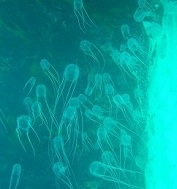

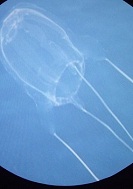
Wikimedia Commons: Peter Southwood
Wikimedia
Commons: GondwanaGirl
Wikimedia Commons: Zaneta Nemcokova
